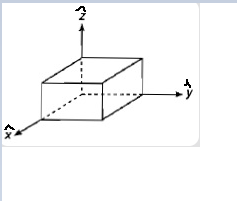
A cube has sides of length L = 0.2 m. It is placed with one corner at the origin as shown in the figure. The electric field is uniform and given by \[=2.5\widehat{i}-4.2\widehat{j}\]. Find the electric flux through the entire cube.


Answer
570.9k+ views
Hint: Electric field is in x-axis and y-axis. There is no field in the z-axis. A cube has 6 faces. Since there is no field in the z-axis, so the flux through the top and down face is zero. Now we need to find flux through the remaining 4 faces.
Complete step by step answer:
One important point to note is the cube is placed in an external field which is given by \[=2.5\widehat{i}-4.2\widehat{j}\]
Now divide this into components we get,
\[{{E}_{x}}=2.5N/C\]
\[{{E}_{y}}=-4.2N/C\]
The origin of the field is not within the cube. Thus, the field lines which enters one face, the same number of lines exit through the opposite face. So-net flux through any two opposite faces is zero. Thus, flux through two opposite surfaces is same and opposite. Hence, the electric flux through the entire cube is zero.
The answer is 0 gauss.
Note:Had it been a case like a charge was situated inside the cube then we would have to apply gauss law to find the net flux through the cube. Gauss law states that the total flux through a closed surface is \[\dfrac{1}{\varepsilon }\]times the total charge inside that surface. Flux is given by the dot product of electric field vector and the area vector, since it involves dot product it is a scalar quantity.
Complete step by step answer:
One important point to note is the cube is placed in an external field which is given by \[=2.5\widehat{i}-4.2\widehat{j}\]
Now divide this into components we get,
\[{{E}_{x}}=2.5N/C\]
\[{{E}_{y}}=-4.2N/C\]
The origin of the field is not within the cube. Thus, the field lines which enters one face, the same number of lines exit through the opposite face. So-net flux through any two opposite faces is zero. Thus, flux through two opposite surfaces is same and opposite. Hence, the electric flux through the entire cube is zero.
The answer is 0 gauss.
Note:Had it been a case like a charge was situated inside the cube then we would have to apply gauss law to find the net flux through the cube. Gauss law states that the total flux through a closed surface is \[\dfrac{1}{\varepsilon }\]times the total charge inside that surface. Flux is given by the dot product of electric field vector and the area vector, since it involves dot product it is a scalar quantity.
Recently Updated Pages
Why are manures considered better than fertilizers class 11 biology CBSE

Find the coordinates of the midpoint of the line segment class 11 maths CBSE

Distinguish between static friction limiting friction class 11 physics CBSE

The Chairman of the constituent Assembly was A Jawaharlal class 11 social science CBSE

The first National Commission on Labour NCL submitted class 11 social science CBSE

Number of all subshell of n + l 7 is A 4 B 5 C 6 D class 11 chemistry CBSE

Trending doubts
What is meant by exothermic and endothermic reactions class 11 chemistry CBSE

10 examples of friction in our daily life

One Metric ton is equal to kg A 10000 B 1000 C 100 class 11 physics CBSE

1 Quintal is equal to a 110 kg b 10 kg c 100kg d 1000 class 11 physics CBSE

Difference Between Prokaryotic Cells and Eukaryotic Cells

What are Quantum numbers Explain the quantum number class 11 chemistry CBSE




